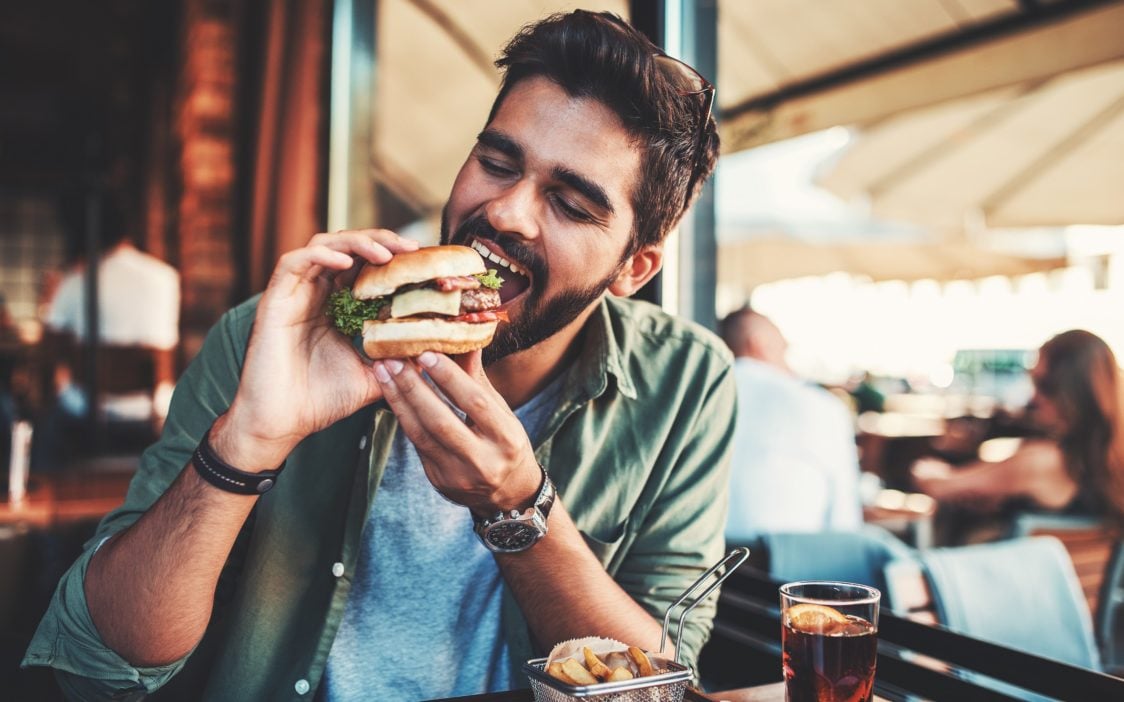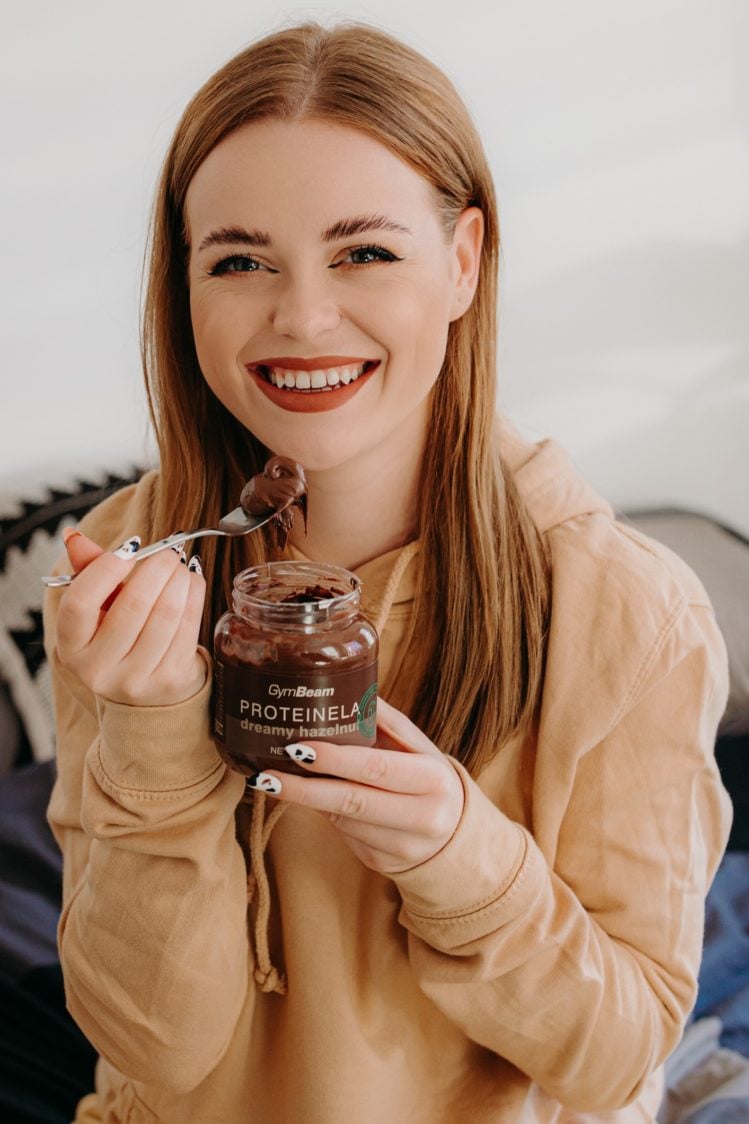Table of Contents
Caloric deficit is a basic requirement for successful weight loss. Although unfortunately many people focus on cutting down on gluten, dairy products or eating only “permitted foods” within their diet, but the relentless law of thermodynamics expressed by the energy balance cannot be fooled. A caloric deficit can be like extraterrestrial life. Everyone believes in one way or another that it exists, but no one has actually seen it with their own eyes yet. Of course, if you are keeping an eye on your macronutrients, you can sort of indirectly see it in a nutritional app. In today’s article, we will show you what that infamous caloric deficit actually is, how to recognize if you are in a caloric deficit and, most importantly, how to manage it without becoming a slave to counting calories.
Food is a source of energy, but also other important nutrients necessary to promote health

Food contains energy, but also vitamins, minerals, biologically active substances such as antioxidants, and perhaps substances that are yet to be discovered. It is very simplistic to look at food only as a source of energy. The body is not a combustion engine, for which it is clear how many miles you drive at full speed. It is an incredibly complex and dynamic tool that responds to nutrient intake.
In a way, food is something like a trigger for specific biochemical reactions in the body, which are quite different for each individual macronutrient. For example, carbohydrates are mainly a source of energy and protein, on the other hand, is essential for the growth and maintenance of muscle mass or as a basic building block for cells of the immune system. [1–3]
Every meal we eat has an impact on how we feel in the short term and on how we look in the long term, and it also affects our health. The food should comprehensively help us to be as healthy as possible, support athletic performance, and to help live a long and active life. Therefore, it does not make any sense to follow, for example, the misunderstood approach of IIFYM (flexible dieting), where people do not care about the quality of food, but primarily focus on “eating foods as long as they fit within macros”. If you are interested in how to be able to treat yourself with a hamburger, for example, and still lose weight, read our article How to Eat Pizza, Sweets, and Still Lose Weight Thanks to IIFYM?
Even when in a caloric deficit, you can eat surprisingly more and lose weight with confidence
It’s not rocket science or black magic. When you replace highly industrially processed foods, which typically have a large amount of energy in a small volume, with as many fresh and minimally processed foods as possible, you will, almost without noticing, reduce your energy intake while improving your diet. In general, people are quite surprised by how much food they can eat while still losing weight.
What does it look like in reality? Peter and Paul are two friends who go out for a meal on a regular basis. Peter usually doesn’t care about his diet that much, so he usually ends up in fast food eating a calorie bomb, while Paul thinks about what he eats, and thanks to that he is able to make healthy choices even in a fast food restaurant.
- Peter orders some food at McDonald’s: Double Big Tasty Bacon (1022 kcal) with large fries (434 kcal) and 0.5 l of Coca-Cola (208 kcal). That is 1,684 kcal for Peter and an almost depleted caloric intake for the whole day on top of that.
- Paul orders some food at McDonald’s: McWrap with grilled chicken (363 kcal) and Caesar salad with grilled chicken (209 kcal), 0.5 l Coca-Cola Zero (0 kcal) and espresso (0) for lunch. That is 572 kcal for Paul and a ”Correct Meal Choice” award.
Where is the difference? Mainly in 1,112 kcal, the content of individual nutrients and also the feeling achieved after the meal. After lunch, Peter is quite tired and without energy, while Paul feels good and can continue working. And if you think that you can just exercise off your bad diet decisions, forget about it right away. For the average 65-kilogram (143 lbs) woman and the 80-kilogram (176 lbs) man to burn the energy hidden in Peter’s meal, the woman would have to run at an average speed of 10 km/h for about 2.5 hours and the man a little over 2 hours. It is much better to learn to eat according to your needs rather than try to do an extra exercise to get rid of the gained energy excess.

How to successfully handle a caloric deficit and weight loss?
When in a caloric deficiency, the body reaches for the energy reserves it has at its disposal. The goal of weight loss is to activate adipose tissue, burn it for energy and get rid of it. There are several ways to support this, which will help you with consistency and perseverance. Keep in mind that caloric deficit which is too high is as detrimental as if it’s too small. A caloric deficit of about 15-20% of your current energy intake is considered sustainable in the long run. [4]
If you want to calculate your energy intake for weight loss, the online calculator in our article Online Energy Intake and Macronutrient Calculator will serve you well.
1. Eat more vegetables, fruits and other foods with low energy density

Above, we have already touched the topic of energy density. It is basically the amount of energy per weight unit. Which one has more calories, 100 grams of chocolate or 100 grams of apples? Intuitively, you somehow know that it’s definitely chocolate, but did you know that the difference can be about 430 kcal?
Adequate intake of fruits and vegetables is associated with more effective weight loss. You may be wondering if this is due to the relatively low energy content and low energy density? No, fruits and vegetables are a rich source of fiber, which makes you feel more satisfied after a meal and thus eat less food.
Soluble fiber also slows down digestion, meaning that your blood sugar levels have a chance to rise slowly and you don’t get the munchies soon after. [5–7]
You should eat at least 400 grams of vegetable and 200 grams of fruit per day. Keep in mind that fruit should be consumed mainly in the solid form, not by drinking. Try to include more vegetable salads or fermented vegetable in your diet. There is so many different ways, you can even try the increasingly popular Korean kimchi.
Thanks to the contained probiotics (friendly bacteria) and prebiotics (dietary fiber for the friendly bacteria), it will also benefit the composition of your microbiome and healthy digestion. The composition of the gut microbiota can also affect weight loss or the immune system and the body’s defence mechanism against diseases. [8–9]
2. Try low-calorie ZERO side dishes
Why should you do it and what is it exactly? The secret of the almost calorie-free side dishes lies in the raw material in the form of gluten-free konjac flour from the plant of Amorphophallus konjac. As a result, ZERO side dishes contain the soluble fiber glucomannan, which, like other types of soluble fiber, binds water in the digestive system and thus increases the volume of digestion. Again, glucomannan helps you to feel more satisfied after a meal because it can bind up to 50 times more water than its weight. [10–11]
You can try, for example, ZERO Noodles, ZERO Rice or ZERO Spaghetti. But keep in mind that these products have a specific taste and need to be properly prepared and seasoned. And if it still isn’t “your cup of tea,” don’t try to push it and choose a different approach.

3. Focus on protein
In short, protein is an essential macronutrient in many areas of the human body’s functioning. When losing weight, you will appreciate the increased protein intake, especially thanks to its positive effect on the feeling of satiety after a meal, and it can also help you manage your uncontrollable cravings. Adequate protein intake when losing weight will also protect your muscles from turning into energy and will also contribute to the body’s optimal defence. [1] [12–14]
Of all nutrients, protein has the greatest thermic effect. This means that the body consumes about 20-30% of their energy content for its metabolism, depending on the type of protein. From 100 kcal, you will in reality receive about 70-80 kcal. This way optimal protein intake can speed up metabolism. Your daily protein intake should be in the wide range of 1.2-2 grams of protein per kilogram of body weight, depending on your physical activity. You can support your protein intake with quality whey or vegetable protein and protein bars. With the opportunities of the modern Western world, it is not necessary to rely only on animal sources of protein. By at least partially replacing animal sources with plant ones, you will benefit yourself, thanks to the higher fiber content, and the planet, thanks to the smaller carbon footprint you leave behind.
If you are interested in protein food sources, read our article 20 Foods Which Can Easily Add Protein to Your Diet.
You might be interested in these products:
4. Partially replace the side dishes with vegetable alternatives
In case you need to reduce the energy content of your larger daily meals, once again, you can use vegetables. This time we will introduce food with which you can at least partially reduce or completely replace your side dishes. Once more, this means that you can eat more with fewer calories.
- Spaghetti → Zucchini spaghetti. In addition to the replacement of classic spaghetti, you can also use zucchini to increase the volume of oat porridge or as an ingredient in baking. Typically, for example, in brownies. There is an average of 18 kcal in 100 grams of zucchini.
- Rice → cauliflower rice. All you have to do is chop the cauliflower to achieve the desired consistency, and then you can fry it, for example, dry or on a small portion of oil with spices to make the taste somewhat special. There is about 27 kcal in 100 grams of cauliflower.
- French fries → celery fries. If you are a French fries lover, and you can’t resist them, try baking celery fries in oven at home. Simply French fry size and mix them in a bowl with a minimum of oil and spices, spread them on a baking sheet and just put them in the oven. There is an average of 35 kcal in 100 grams of celery. If you don’t like celery, just bake home-made French fries at home from regular potatoes with a minimum of oil and spices according to your taste.
If for any reason you exclude pastries from your diet, you can prepare “hamburger buns” from portobello mushrooms or a few leaves of iceberg lettuce. There is no limit to culinary art, and it’s up to you how you cook your food.

5. Ensure adequate fiber intake
Adequate fiber intake promotes healthy digestion, microbiome, and also weight loss. In particular, soluble fiber generally promotes satiety, slows digestion, so you can feel more satisfied after eating and eat less food. It is generally recommended to have about 30 grams of fiber per day for its health benefits. [10]
- Therefore, focus on whole grains, legumes, unpeeled vegetables and fruits (cucumber, apple or home-grown carrot), nuts and seeds. You can also use chicory syrup to sweeten foods as it contains about 70% soluble fiber called inulin. As a result, it contains about 5 grams of sugar in 100 grams.
- You can also reach for dietary supplements containing fiber. Among the most popular is the fiber of Sand plantain, better known as psyllium. Apple fiber is also beneficial. Both these sources of fiber can be added, for example, to dairy products, oat porridge or breakfast cereals with milk.
- Remember glucomannan? This is the type of fiber that can bind up to 50 times more water than its weight, and thus increase the volume in your digestive tract. As a result, it is one of the increasingly popular dietary supplements to support weight loss. If you don’t like its taste, you can try glucomannan capsules.
Even EFSA (European Food Safety Authority) has approved following nutrition claims about glucomannan:
- Glucomannan in the context of an energy-restricted diet contributes to weight loss. With a daily intake of at least 3 grams of glucomannan.
- Glucomannan helps maintain normal blood cholesterol levels. With a daily intake of at least 4 grams of glucomannan.

6. Don’t drink empty calories and learn how to cut lots of calories using sweeteners.
It is okay to have protein to replenish nutrients or meal replacement to replace one daily meal. But regularly drinking a litre of Coca-Cola or other sweetened soda is not okay. Unnecessarily, you get the same amount of energy that an average lunch contains. Build your drinking schedule on water and limit liquid calories as much as possible.
You can’t imagine your life without sweet foods? Then learn to sweeten smartly and even without calories. All you need to do is at least partially replace sugar with, for example, the calorie-free sweetener erythritol, which has almost the same sweetness as sugar and can be found naturally in some fruits. You can also try xylitol, chicory syrup, stevia or calorie-free syrups to decorate pancakes or other sweet desserts. If you are interested in more tips on how to enjoy sweet treats and not gain weight, read our article 7 Tips on How to Eat What You Like and Not Gaining Weight.

7. Control your food portions and do not nibble

When it comes to estimating your caloric intake, even nutrition therapists and nutritionists think they are consuming less energy than they actually are. A good way to keep track of your nutrition is to complete at least two weeks of weighing your food and enrolling in nutritional apps, such as MyFitnessPal or Yazio. This will give you a far greater overview of your food, and you do not have to become a slave to counting calories. [15]
And what if you don’t want to do that? Create a food system that suits you. You can start with 2-3 larger meals, suitably complemented by snacks, and start using smaller plates.
In modern society, everything is getting bigger. Including larger food packages or plates. One study shows that the size of today’s plates is up to 44% larger than it was in 1990. And larger plates lead to higher energy intake, and thus weight gain. [16–17]
Try it the other way around and serve your food on a smaller plate for at least 1 or 2 of your daily meals. And if you’re still hungry after eating, have just a little bit more. But remember that it takes a while for the impulse that you have “had enough” to appear. Wait at least a few minutes before getting another portion, and you may find that you are actually not hungry anymore. It may be a better strategy than serving a big portion that will cause a food coma and make you laze around. [16–17]
If you are interested in how nibbling throughout the day may be stopping you from losing weight, read our article How Is Snacking Holding You Back from Losing Weight? 11 Easy Ways to Get Food Under Control.
8. Use cooking oil wisely and try low-calorie sauces
You can literally kill any low-calorie diet food by using excessive amounts of oil or mayonnaise. An example for all of them is Caesar salad, which can even have as many calories as a good hamburger. But in this case, will you feel more satisfied after a burger or salad?
Use a minimum amount of oil to prepare meals, spray oil is an ideal option for this. And instead of various high-calorie sauces, give calorie-free sauces and syrups a chance.

9. Exercise, but don’t push it too far…

Properly set physical activity can effectively fight with your cravings. In this context, the positive effect of strength training is something to talk about. But even endurance sports are something to consider. The problem is that undergoing excessive stress in the form of endurance activity can actually stimulate your appetite. [18]
Unfortunately, everyone is different, so you are likely to observe a slightly diverse effect on yourself. Generally speaking, the people who regularly engage in sports, may have improved their “internal appetite stimulating system”. You can start, for example, with 2-4 strength trainings during the week appropriately supplemented with your favourite endurance activity or other sport. [18]
Remember that when it comes to focusing on strength exercises, there is no need to push too hard on your endurance training. About an hour of aerobic activity on non-training days and, for example, an active weekend could be enough. Devote enough time to the regeneration as well because the body absolutely needs it after an exhausting exercise. After some time, you will learn to listen to your body and know when it’s time to rest instead of exercising. [18]
But do not forget to get as much natural movement as possible during the day. This is one of the most important factors that determines the success of weight loss. If you are interested in this topic, read our article What Is the Most Important Factor in Weight Loss?
10. Sleep more
Here we go with the sleep again. But in fact, it is really important. Otherwise, we wouldn’t spend about a third of our lives sleeping. It could be said that sleep is one of the most effective refreshers and also fat burners. Lack of sleep is closely linked to increased weight and obesity. It affects the hormones of hunger and satiety (leptin & ghrelin), which makes you crave more food and feel less satisfied after eating. And when you don’t get enough sleep, you don’t even think about working out, do you? These are just a few of the many reasons why you should sleep more. [19–21]
Therefore, treat yourself to about 7-9 hours of undisturbed and high-quality sleep every night. You will see that you will feel much more energetic. [22]

What is the lesson?
Food is not just an ordinary fuel for you to think well, do sports and make whole organism function optimally. It’s much more. Therefore, the caloric deficit cannot be understood as “you can eat anything as long as it fits your macros”. Each nutrient has a predestined metabolic fate and an ideal diet plan should contain enough of all macronutrients, vitamins, minerals, trace elements, phytochemicals, probiotics, prebiotics and other biologically active substances that have a positive effect on human health.
You can easily support weight loss and caloric deficit by consuming enough protein and fiber from various sources, controlling your portions or by not drinking extra calories. Physical activity is basically a must, while sufficient sleep is a key to maintaining good health and successful weight loss.
And how do you deal with caloric deficit? Share your advice and tips in the comments. If you liked the article, support it by sharing, so that your friends can also learn how to promote weight loss and caloric deficit.
[1] Ralf Jäger, Kerksick, C. M., Campbell, B. I., Cribb, P. J., Wells, S. D., Skwiat, T. M., Purpura, M., Ziegenfuss, T. N., Ferrando, A. A., Arent, S. M., Smith-Ryan, A. E., Stout, J. R., Arciero, P. J., Ormsbee, M. J., Taylor, L. W., Wilborn, C. D., Kalman, D. S., Kreider, R. B., Willoughby, D. S., … Antonio, J. – International Society of Sports Nutrition Position Stand: Protein and exercise – https://doi.org/10.1186/s12970-017-0177-8
[2] Kurpad, A. V. – The requirements of protein & amino acid during acute & chronic infections – https://pubmed.ncbi.nlm.nih.gov/17015927/
[3] Slavin, J., & Carlson, J. – Carbohydrates1. – https://doi.org/10.3945/an.114.006163
[4] Speakman, J. R., & Mitchell, S. E. – Caloric restriction. – https://doi.org/10.1016/j.mam.2011.07.001
[5] Sharma, S. P., Chung, H. J., Kim, H. J., & Hong, S. T. Paradoxical Effects of Fruit on Obesity. – https://doi.org/10.3390/nu8100633
[6] Tapsell, L. C., Dunning, A., Warensjo, E., Lyons-Wall, P., & Dehlsen, K. – Effects of vegetable consumption on weight loss: A review of the evidence with implications for design of randomized controlled trials. – https://doi.org/10.1080/10408398.2011.642029
[7] Nour, M., Lutze, S. A., Grech, A., & Allman-Farinelli, M. – The Relationship between Vegetable Intake and Weight Outcomes: A Systematic Review of Cohort Studies. – https://doi.org/10.3390/nu10111626
[8] Althani, A. A., Marei, H. E., Hamdi, W. S., Nasrallah, G. K., Zowalaty, E., E, M., Al Khodor, S., Al‐Asmakh, M., Abdel‐Aziz, H., & Cenciarelli, C. – Human Microbiome and its Association With Health and Diseases. – https://doi.org/10.1002/jcp.25284
[9] Marco, M. L., Heeney, D., Binda, S., Cifelli, C. J., Cotter, P. D., Foligné, B., Gänzle, M., Kort, R., Pasin, G., Pihlanto, A., Smid, E. J., & Hutkins, R. – Health benefits of fermented foods: Microbiota and beyond. – https://doi.org/10.1016/j.copbio.2016.11.010
[10] Slavin, J. L. – Dietary fiber and body weight. – https://doi.org/10.1016/j.nut.2004.08.018
[11] Keithley, J. K., Swanson, B., Mikolaitis, S. L., DeMeo, M., Zeller, J. M., Fogg, L., & Adamji, J. – Safety and Efficacy of Glucomannan for Weight Loss in Overweight and Moderately Obese Adults. – https://doi.org/10.1155/2013/610908
[12] Pesta, D. H., & Samuel, V. T. – A high-protein diet for reducing body fat: Mechanisms and possible caveats. – https://doi.org/10.1186/1743-7075-11-53
[13] Astrup, A., Raben, A., & Geiker, N. – The role of higher protein diets in weight control and obesity-related comorbidities. – https://doi.org/10.1038/ijo.2014.216
[14] Westerterp-Plantenga, M. S., Lemmens, S. G., & Westerterp, K. R. – Dietary protein – its role in satiety, energetics, weight loss and health. – https://doi.org/10.1017/S0007114512002589
[15] Champagne, C. M., Bray, G. A., Kurtz, A. A., Monteiro, J. B. R., Tucker, E., Volaufova, J., & Delany, J. P. – Energy intake and energy expenditure: A controlled study comparing dietitians and non-dietitians. – https://doi.org/10.1016/s0002-8223(02)90316-0
[16] Benton, D. – Portion size: What we know and what we need to know. – https://doi.org/10.1080/10408398.2012.679980
[17] Rolls, B. J., Morris, E. L., & Roe, L. S. – Portion size of food affects energy intake in normal-weight and overweight men and women. – https://doi.org/10.1093/ajcn/76.6.1207
[18] Dorling, J., Broom, D. R., Burns, S. F., Clayton, D. J., Deighton, K., James, L. J., King, J. A., Miyashita, M., Thackray, A. E., Batterham, R. L., & Stensel, D. J. – Acute and Chronic Effects of Exercise on Appetite, Energy Intake, and Appetite-Related Hormones: The Modulating Effect of Adiposity, Sex, and Habitual Physical Activity. – https://doi.org/10.3390/nu10091140
[19] Coughlin, J. W., & Smith, M. T. – Sleep, obesity, and weight loss in adults: Is there a rationale for providing sleep interventions in the treatment of obesity? – https://doi.org/10.3109/09540261.2014.911150
[20] Luboshitzky, R., Zabari, Z., Shen-Orr, Z., Herer, P., & Lavie, P. – Disruption of the nocturnal testosterone rhythm by sleep fragmentation in normal men. – https://doi.org/10.1210/jcem.86.3.7296
[21] Beccuti, G., & Pannain, S. – Sleep and obesity. – https://doi.org/10.1097/MCO.0b013e3283479109
[22] Hirshkowitz, M., Whiton, K., Albert, S. M., Alessi, C., Bruni, O., DonCarlos, L., Hazen, N., Herman, J., Katz, E. S., Kheirandish-Gozal, L., Neubauer, D. N., O’Donnell, A. E., Ohayon, M., Peever, J., Rawding, R., Sachdeva, R. C., Setters, B., Vitiello, M. V., Ware, J. C., & Adams Hillard, P. J. – National Sleep Foundation’s sleep time duration recommendations: Methodology and results summary. – https://doi.org/10.1016/j.sleh.2014.12.010


Add a comment